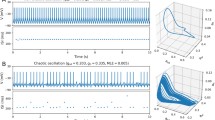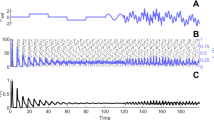Abstract
Spatiotemporal waves of synchronized activity are known to arise in oscillatory neural networks with lateral inhibitory coupling. How such patterns respond to dynamic changes in coupling strength is largely unexplored. The present study uses analysis and simulation to investigate the evolution of wave patterns when the strength of lateral inhibition is varied dynamically. Neural synchronization was modeled by a spatial ring of Kuramoto oscillators with Mexican hat lateral coupling. Broad bands of coexisting stable wave solutions were observed at all levels of inhibition. The stability of these waves was formally analyzed in both the infinite ring and the finite ring. The broad range of multi-stability predicted hysteresis in transitions between neighboring wave solutions when inhibition is slowly varied. Numerical simulation confirmed the predicted transitions when inhibition was ramped down from a high initial value. However, non-wave solutions emerged from the uniform solution when inhibition was ramped upward from zero. These solutions correspond to spatially periodic deviations of phase that we call ripple states. Numerical continuation showed that stable ripple states emerge from synchrony via a supercritical pitchfork bifurcation. The normal form of this bifurcation was derived analytically, and its predictions compared against the numerical results. Ripple states were also found to bifurcate from wave solutions, but these were locally unstable. Simulation also confirmed the existence of hysteresis and ripple states in two spatial dimensions. Our findings show that spatial synchronization patterns can remain structurally stable despite substantial changes in network connectivity.









Similar content being viewed by others
References
Abrams DM, Strogatz SH (2004) Chimera states for coupled oscillators. Phys Rev Lett 93(17):174,102
Amari S (1977) Dynamics of pattern formation in lateral-inhibition type neural fields. Biol Cybern 27(2):77–87
Benucci A, Frazor RA, Carandini M (2007) Standing waves and traveling waves distinguish two circuits in visual cortex. Neuron 55(1):103–117
Breakspear M, Heitmann S, Daffertshofer A (2010) Generative models of cortical oscillations: neurobiological implications of the Kuramoto model. Front Hum Neurosci 4:190
Delaney KR, Gelperin A, Fee MS, Flores JA, Gervais R, Tank DW, Kleinfeld D (1994) Waves and stimulus-modulated dynamics in an oscillating olfactory network. PNAS 91(2):669–673
Dhooge A, Govaerts W, Kuznetsov YA (2003) MATCONT: a MATLAB package for numerical bifurcation analysis of ODEs. ACM Trans Math Softw 29(2):141–164
Ermentrout B (1996) Type I membranes, phase resetting curves, and synchrony. Neural Comput 8(5):979–1001
Ermentrout B (1998) Neural networks as spatio-temporal pattern-forming systems. Rep Prog Phys 61:353
Ermentrout B, Flores J, Gelperin A (1998) Minimal model of oscillations and waves in the limax olfactory lobe with tests of the model’s predictive power. J Neurophysiol 79(5):2677–2689
Ermentrout GB (1981) Stable small-amplitude solutions in reaction–diffusion systems. Q Appl Math 39(1):61–86
Ermentrout GB (1985) The behavior of rings of coupled oscillators. J Math Biol 23(1):55–74
Ermentrout GB, Kleinfeld D (2001) Traveling electrical waves in cortex: insights from phase dynamics and speculation on a computational role. Neuron 29(1):33–44
Fife PC (1978) Asymptotic states for equations of reaction and diffusion. Bull Am Math Soc 84(5):693–726
Friston KJ (1994) Functional and effective connectivity in neuroimaging: a synthesis. Hum Brain Mapp 2(1–2):56–78
Friston KJ (2011) Functional and effective connectivity: a review. Brain Connect 1(1):13–36
Girnyk T, Hasler M, Maistrenko Y (2012) Multistability of twisted states in non-locally coupled Kuramoto-type models. Chaos 22(1):013,114
Hansel D, Mato G, Meunier C (1995) Synchrony in excitatory neural networks. Neural Comput 7(2):307–337
Heitmann S, Gong P, Breakspear M (2012) A computational role for bistability and traveling waves in motor cortex. Front Comput Neurosci 6(67):1–15
Heitmann S, Boonstra T, Breakspear M (2013) A dendritic mechanism for decoding traveling waves: principles and applications to motor cortex. PLoS Comput Biol 9(10):e1003,260
Huang X, Troy WC, Yang Q, Ma H, Laing CR, Schiff SJ, Wu JY (2004) Spiral waves in disinhibited mammalian neocortex. J Neurosci 24(44):9897–9902
Jirsa VK, McIntosh AR (2007) Handbook of brain connectivity, vol 1. Springer, Berlin
Kazanci FG, Ermentrout B (2007) Pattern formation in an array of oscillators with electrical and chemical coupling. SIAM J Appl Math 67(2):512–529
Kuramoto Y (1984) Chemical oscillations, waves, and turbulence. Springer, Berlin
Laing CR (2009) The dynamics of chimera states in heterogeneous Kuramoto networks. Phys D Nonlinear Phenom 238(16):1569–1588
Lubenov EV, Siapas AG (2009) Hippocampal theta oscillations are travelling waves. Nature 459(7246):534–539
Nauhaus I, Busse L, Carandini M, Ringach DL (2009) Stimulus contrast modulates functional connectivity in visual cortex. Nat Neurosci 12(1):70–76
Omel’chenko E, Wolfrum M, Laing CR (2014) Partially coherent twisted states in arrays of coupled phase oscillators. Chaos 24(2):023,102
Rinzel J, Ermentrout GB (1998) Analysis of neural excitability and oscillations. Methods Neuronal Model 2:251–292
Rubino D, Robbins K, Hatsopoulos N (2006) Propagating waves mediate information transfer in the motor cortex. Nat Neurosci 9(12):1557–1549
Sethia GC, Sen A, Atay FM (2011) Phase-locked solutions and their stability in the presence of propagation delays. Pramana 77(5):905–915
Sporns O, Tononi G, Edelman GM (2000) Connectivity and complexity: the relationship between neuroanatomy and brain dynamics. Neural Netw 13(8):909–922
Tononi G, Sporns O, Edelman GM (1994) A measure for brain complexity: relating functional segregation and integration in the nervous system. PNAS 91(11):5033–5037
Wiley DA, Strogatz SH, Girvan M (2006) The size of the sync basin. Chaos 16(1):015,103
Wu JY, Huang X, Zhang C (2008) Propagating waves of activity in the neocortex: what they are, what they do. Neuroscientist 14(5):487–502
Author information
Authors and Affiliations
Corresponding author
Additional information
This work was funded by USA National Science Foundation (NSF) award 1219753.
Electronic supplementary material
Below is the link to the electronic supplementary material.
Supplementary material 1 (mpg 6570 KB)
Supplementary material 2 (mpg 8821 KB)
Rights and permissions
About this article
Cite this article
Heitmann, S., Ermentrout, G.B. Synchrony, waves and ripple in spatially coupled Kuramoto oscillators with Mexican hat connectivity. Biol Cybern 109, 333–347 (2015). https://doi.org/10.1007/s00422-015-0646-6
Received:
Accepted:
Published:
Issue Date:
DOI: https://doi.org/10.1007/s00422-015-0646-6




